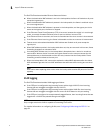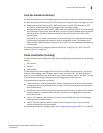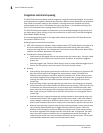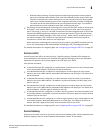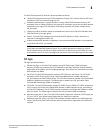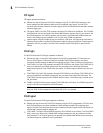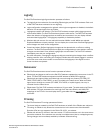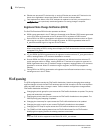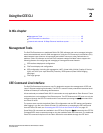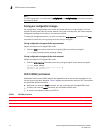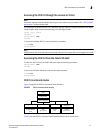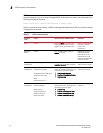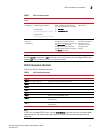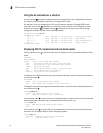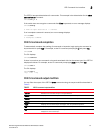
12 Dell Converged Enhanced Ethernet Administrator’s Guide
53-1002116-01
FCoE queuing
1
• ENodes can access all FC devices with no zoning—ENodes can access all FC devices in the
fabric when cfgdisable is issued and Default Zone is set to All Access Mode.
• Field replacement—When a Dell FCoE hardware is replaced in the field, you can perform a
configdownload on a previously saved configuration. No zoning change is required.
Registered State Change Notification (RSCN)
The Dell FCoE hardware RSCN function operates as follows:
• RSCN events generated in the FC fabric are forwarded to the ENodes. RSCN events generated
on the FCoE side are forwarded to the FC devices. CEE is not aware of RSCN events.
• Device RSCN—An RSCN is generated to all registered and affected members when an ENode
either logs in or logs out of an FCF through any means. An RSCN is generated when an FC
N_port device either logs in or logs out of the FC fabric.
NOTE
When transmitting an RSCN, zoning rules still apply for FCoE devices as the devices are treated
as regular FC N_ports.
• VF_port RSCN—An RSCN is generated to all registered members when a VF_port goes online or
offline, causing ENode or FC devices to be added or removed.
• Domain RSCN—An RSCN is generated to all registered and affected members when an FC
switch port goes online or offline, causing ENode or FC devices to be added or removed. An
RSCN is generated when two FC switches merge or segment, causing ENode or FC devices to
be added or removed. When FC switches merge or segment, an RSCN is propagated to
ENodes.
• Zoning RSCN—An RSCN is generated to all registered and affected members when a zoning
exchange occurs in the FC fabric.
FCoE queuing
The QOS configuration controls the FCoE traffic distribution. Note that changing these settings
requires changes on both the Dell FCoE hardware and the CNA; therefore, the link must be taken
offline and back online after a change is made. Traffic scheduler configuration changes affect
FCoE traffic distribution as follows:
• Changing the priority group for a port causes the FCoE traffic distribution to update. The priority
group and bandwidth are updated.
• Changing the priority table for a port causes the FCoE traffic distribution to be updated. The
COS-to-priority group mapping is updated.
• Changing the class map for a port causes the FCoE traffic distribution to be updated.
• Changing the policy map for a port causes FCoE traffic distribution to be updated.
• Changing the CEE map for a port causes the FCoE traffic distribution to be updated.
• The FCMAP to VLAN mapping determines the FCoE VLAN allowed for the FCoE session.
Modifying this mapping causes the existing sessions to terminate.
NOTE
Only one FCoE VLAN is supported in the Fabric OS v6.3.1_cee release.



